
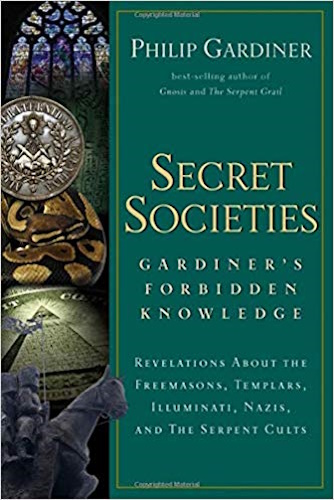



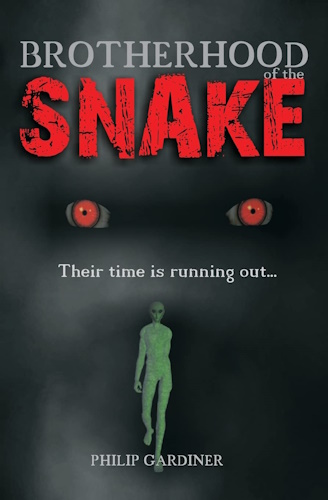



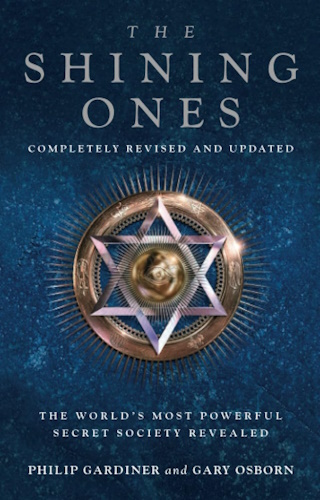

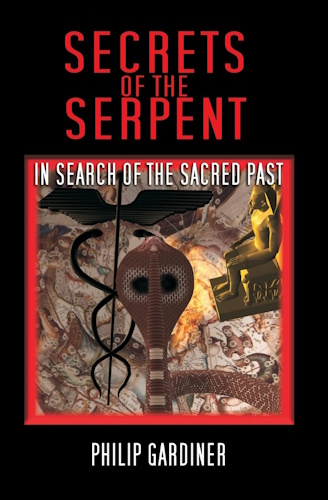

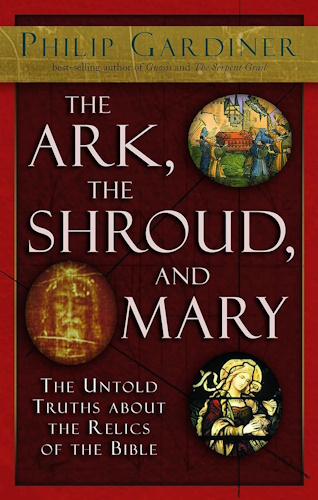


Secret Societies:
Gardiner's Forbidden Knowledge
Revelations About the Freemasons,
Templars, Illuminati, Nazis,
and the Serpent Cults
by
Philip Gardiner
2007
from IndyBay Website
![]()
![]()
8 - Here Be Dragons
The Sacred Places of Ancient Secret Societies
The secret societies of the globe from ancient times down to today all had many things in common.
Not the least of which was the need for a place to meet.
But what was the origin of the symbolism of a temple or a lodge?
Why is this place a stairway to heaven? A gateway to another world?
And why is the serpent or dragon often involved?
If we go back across the mists of time to the original meeting places of the serpent cults and shining secret orders, will we discover the secrets of the mysterious landscape that now surrounds us?
Over the course of many years and with more air-miles than I care to remember, I have journeyed on a quest to uncover the secrets of the ancient serpent cults that I reveal in my books.
Each time I journey, I discover something new. There truly is a whole new world opening up before our eyes. Suddenly, and often without warning, I am faced with a reinterpretation of history that I am simply not looking for.
In another twist in the tale of the serpent, I am about to uncover before your eyes one of the ancient truths about dragons, remembering that, in myth and in ancient history, dragons and serpents are intertwined like the coils of a pit viper.
I shall to begin in America of all places, for two reasons. Firstly, that this is the last place I would even consider looking for dragons, and, secondly, because the evidence is most profound here in archaeological terms.
The evidence of serpent worship in the Americas can largely be shown by the many serpent mounds that appear across the continent. The most famous by a long way is the "Serpent Mound" of Ohio, Adams County.
According to some, 1 this marvelous mound is related to Stonehenge, and it is the "Dragon Guardian" of the East to Stonehenge's Secret of the West. Indeed, it is thought that the two ancient structures actually do share the same timeline and may very well have a relationship to each other - if ancient man shared the same beliefs and traveled extensively, as is the growing belief of many scholars.
Of course, Stonehenge is also directly north of that infamous serpent temple, Avebury.

Dragon at Cistercian monastery
Avebury is a huge British temple and stone monument erected around 2000 B.C. in the shape of a serpent when seen from the sky.
Once known as Abury which, according to Deane, 2 is evidently Abiri or Ab-ir (after the Abiri people or Cabiri who were serpent worshippers). Abir means the solar snake or fire snake.
Although some have argued whether Avebury was ever Abury or Aubury (serpent sun), the fact remains that even as far back as the 17th century there was a Mr. Aubury who said that it should be pronounced and spelled Aubury (found in the ledger book of Malmesbury Abbey).
Of course even as Ave Bury, the "Ave" reverts back to the root of "Eve" which I know means "female serpent." The pathway of Avebury passes through a large circular temple of the sun, emerging, and then winding again and ending with an oddly, not quite circular head - directly in line with "Snakes Head Hill" (Hackpen).
The central circle is symbolic of the sun, which is the male principle in the creative process and is symbolized elsewhere as a bull or lion. Once the serpent has passed through or around this sun circle it is recharged for new life.
In Egyptian hieroglyphs, we can see similar imagery with the symbol of the snake going over the solar disc, emerging with its head erect. Overlaid onto Avebury it is the same image! Adding to this, that the snake is often depicted with the ancient Egyptian ankh symbol dangling from its emergent neck - the Ankh being a symbol of new life - the great circle of Avebury simply has to be the "solar disk," and the pathway is the snake - thus illustrating in a painfully labor-intensive way, the ritualistic path of the serpent worshipper toward new life.
The circular aspect of the stone circles of Europe are strangely reminiscent of the temples of Quetzalcoatl, which were "circular, and the one dedicated to his worship in Mexico, was entered by a door like unto the mouth of a serpent" 3 - a very similar ritualistic inference to those based around Avebury and other stone circles.
In his book the Worship of the Serpent Traced Throughout the World, John Bathurst Deane explains,
"A third description of temples consecrated to the service of the Ophites' god remains to be considered: and these were not only the most rare, the most characteristic, and the most magnificent; but, probably, the most sacred of them all. These were erected in the form of the Ophite hierogram, the serpent passing through a circle."
This hierogram is the symbol of the serpent, a circle with a snake passing through it, like a needle and thread.
He continues,
"They were composed, like the circular temples, of a number of Baitulia, or amber stones, so arranged as to describe the mystic circle, through which the still more mystic serpent trailed his majestic form."
And this is the truth of the Stone Circles and physical hierograms: that they were rebirthing circles (a being born again through the spirit, through the circle).
I can even make a remarkable deduction from the strange word "baitulia" mentioned previously by Deane - these are betyl stones or serpents' eggs. In Wales, the serpents were said to emerge and congregate on Midsummer's Eve to blow into the Serpent Stone-Eggs or Glain Neidr, which is reminiscent of the Roman historian Pliny's tale of this activity among the Gauls.
These serpent stones were said to be colored pebbles, which gave "second sight" and healing. Midsummer's Eve was the night when the serpents would role themselves into hissing balls and create the glain egg, also known as "snake stone" or "Druid's egg." In Welsh myth, even Merlin himself went in search of them.
The egg, Cosmic Egg, or Cosmogenic Egg is universally seen with the serpent - as in the symbol of the Orphic Egg shown with a snake wrapped around it. From the serpent mound of Ohio to Mithras and Cneph, the egg is associated with serpent worship.
Why?
According to most scholars, it is the emblem of the mundane elements coming from the creating god. Therefore, it is a symbol of the elements of the universe. Surely there is also another reason, a reason that would relate to early man more than such complex ideas sprung into the mind of modern scientists and scholars.
What is an egg? Simply an "entry portal" into this world. A device to give life.
And what animal is seen in relation to this unique device and portal? It is the snake. Again, it is the snake - a symbol of the life force - that creates the device, which gives life.
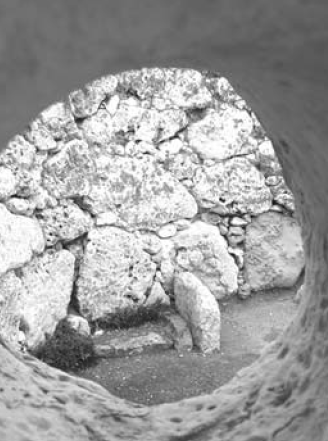
Megalithic hole from the serpent island of Gozo
The Egyptian creator deity, Cneph, was represented as a serpent with an egg thrusting from his mouth, similar to the Ohio Serpent Mound and other places.
From this egg proceeded the deity Ptah, or Phtha - the creative power and "father god" who is the same as the Indian Brahma. These Brahma have been related by scholars to the Jewish Essene community and also to Mithra I.
Mithra was encircled by serpents and can be equated in many ways to Jesus, being a solar divinity and reborn on the 25th of December, like the sun.
There is little wonder that a Persian god, such as Mithra, and a Judaic semi-deity, such as Jesus, would be linked when one understands that the folds of the ancient serpent cult were so all-encompassing that they encircled the globe like a Leviathan.
We can even see elements of this when Jesus is equated to the Brazen Serpent of Moses when we are told to be wise as serpents and that he even shed his shroud or skin once crucified upon the cross. Incidentally, snakes are still, to this day, nailed to trees in certain parts of Africa as a sacrifice for our sins and for healing remedies.
And so we have circular monuments and serpent mounds associated with the egg, which from all the evidence simply gives us the conclusion that these were places of rebirth. One would push through the symbolic circle, or out of the egg, or slough off the old skin, but there is more evidence yet to be unearthed and which reveals this sloughing of the skin to be linked with these ancient sites.
The classical Greeks frequently depicted a serpent squeezing between two upright stones, which they called Petrae Ambrosiae (stone or rock ambrosia), noting that Ambrosia is the nectar and Elixir of the gods.
According to the 19th century archaeologist, Bryant, Stonehenge was seen as amber stones, with nearby Amesbury - previously Ambrosbury - as proof. In this way, the healing abilities of the megalithic stones are attributed to the serpent. In fact, we do still find traces of this in many stories about dragons, who protect, serve, and heal those ancient people of the stones.
The antiquarian and stone circle-spotter extraordinaire William Stukely also found two other "serpent temples" - one at Shap in Westmorland and the other at Classerness in the island of Lewis.
Stukely thought that the Greek legend of Cadmus sowing dragons' teeth alluded to his building a serpentine temple. Cadmus was turned into a serpent (or followed the serpent cult), and stone temples were erected in his and Harmonia's honor.
Pausanius helps us along and points out that,
"In the road between Thebes and Gilsas, you may see a place encircled by select stones, which the Thebans call The Serpent's Head." 4
So, ancient tales may be clues to the real identities of the serpents and dragons of fable, and these real identities may in fact be literal places and monuments. Places where, perhaps, snakes were held in high esteem by the ancient Ophites or serpent worshippers of the world.
There are many more texts mentioning dragons and serpents, such as the one that Taxiles showed to Alexander the Great, which was sacred to Dionysus. It was said to be of enormous size, walled around, and resided in a low, deep place. It is my conjecture that such places, similar to Stonehenge, were "portals" or "gateways" to the "land of the serpents" - places of mystery and rebirth, where offerings and sacrifices must be made to the serpent benefactor.
Indeed, there is plenty of evidence now from people such as Paul Devereux that shows such places were also great resonance boosters.
That is, they amplified sound in peculiar ways, thus creating the booming sound of the dragon. Such scholars even go as far as saying that the resonance creates spiral and serpent wavelike shapes from the dust and smoke, as the sound wave carries the particles along its serpentine path. The serpent could truly have been seen to rise and heard to roar.
However, most people are not aware that similar mounds and monuments also appear elsewhere and often associated with the serpent or dragon in similar ways.
In 1871, at the meeting of the British Association in Edinburgh, a certain Mr. Phene gave an account of his discovery in Argyllshire of a similar mound,
"several hundred feet long, 15 feet high, and 30 feet broad."
The tail tapered away, and a circular cairn, which he presumed to be the solar disk above the head of the "Egyptian uraeus," surmounted the head.
This amazingly is not the only instance of huge serpentine images upon the ground. In the Zend Avesta of the Zoroastrians, one of the heroes takes a rest on what he thinks is a bank - only to find out that it was a green snake!
Iphicrates related that in Mauritania "there were dragons of such extent that grass grew up on their backs," thus showing the highly likely chance that tales of massive dragons in far-off lands could easily be serpent mounds.
Other instances of serpent mounds, however, are to be found mentioned by Strabo (Lib xv. P.1022), in which two dragons are said to have resided in the mountains of India, one 80 cubits long and the other 140.
Posidonius also tells of one in Syria, which was so large that horse riders on either side could not see each other. Each "scale" was as big as a shield, so that a man "might ride into his mouth."
Bryant concurs with the belief that these must be ruins of Ophite temples.
And for what were these temples used?
In ancient Egyptian papyri and in the Mesoamerican codex borgia, there are instances or tales of the king entering the serpent and going through it in order to be resurrected - much like those I find in the myth of Osiris.
This is exactly the same process that lodges and temples today are used for in modern secret societies. In Freemasonic rituals, the initiate must be hung, placed in a coffin, and then called forth like Lazarus in the Bible. In my own ritual, I was ritually slaughtered and then brought back to life by the symbolic energy of the snake.
A book said to have been written by Votan (Quetzalcoatl) in the language of the Quiches and thought to have been in the possession of Núñez de la Vega, the Bishop of Chiapas, also has some revealing elements. So revealing that the Bishop tried to burn it. Votan says he left Valum Chivim 5 and came to the New World to apportion land among seven families who came with him and were said to be culebra or of "serpent origin."
Passing the "land of 13 snakes" he arrived in Valum Votan, founding the city of Nachan (City of Snakes), thought to be modern day Palenque, possibly around 15 B.C. or even earlier. Votan is said to have made four trips to the east and even to have visited Solomon.
An interesting aspect of serpent mounds is the description of a subterranean passage, which is said to terminate at the root of "heaven."
This was called a "snake's hole" and Votan was only allowed in because he was the son of a snake. Surely this can only mean that Votan was an initiate in the serpent cult and that there was a ritualized serpent mound or pyramid which led to snake heaven or Patala.
The Fenian heroes of ancient Ireland are recorded orally in song, and one of them, Fionn, was their "dragon slayer."
One of the legends tells us that:
It resembles a great mound, its jaws were yawning wide; There might lie concealed, though great its fury, A hundred champions in its eye-pits. Taller in height than eight men, Was its tail, which was erect above its back; Thicker was the most slender part of its tail, Than the forest oak which was sunk by the flood.
Fionn asked where this great monster had come from and was told,
"From Greece, to demand battle from the Fenians."
It seems that the serpent worshippers had come to Ireland from Greece, and had fought the ancient inhabitants, leaving behind such terror of them that they became symbolized as this great "dragon mound."
Fionn, it is said, opened the side of the dragon and released the men, going on to kill it. It may be that there is a mixture of wartime fact built in with ritualistic truth in this legend. Emerging from the side of the dragon, as in other myths, gives new life.
The rituals of the secret societies date back thousands of years and have their origin, yet again, in the worship of the serpent.
With the oncoming of orthodox Christianity, Islam, and Judaism, this serpent worship was eradicated and went underground - emerging it seems in the guise of secret societies. Here we have archaeological and textual evidence that the ancient mounds of the world were rebirthing places for these ancient cults that were wiped out, adapted, or swallowed up by the dominant cults (Christianity, and so on).
Obviously the lodges and temples themselves would take on many more symbolic devices as time passed by - such as symbolism from the Temple of Solomon.
Notes
1. See: www.greatserpentmound.org.
2. John Bathurst Dean in Worship of the Serpent Traced Throughout the World and its Traditions Referred to the Events in Paradise (1830). Deane also believed that the Kaaba or Caabir of the Muslims - which was a conical stone - resolved itself into Ca Ab Ir - the "Temple of the Serpent Sun."
Avebury is a huge British temple and stone monument erected at least 2000–2600 B.C. in the shape of a serpent if seen from the sky. Today it is a world heritage site, and one of Europe's largest, encompassing a small hamlet and enclosed by a massive ditch, which required the movement of 200,000 tons of rock, chipped away by the crudest of tools. The circle itself was originally composed of 98 stones (but alas only 27 remain) and was erected around 2500 B.C. The two smaller inner circles were probably erected around 2600 B.C. Leading away from this is the avenue that snakes along, and it was Stukely, the antiquarian, who first noted that the ground plan of the Avebury complex was the representation of a serpent passing through a circle - forming what he believed to be a popular alchemical symbol.
In essence, the serpent is the symbol of the power or energy and indeed wisdom that is derived from the sun - something our ancestors closely associated with life. Of course, the precession of the earth is also built into Avebury, so one could easily discover, as if by magic, where and when in the great cycle one was. This skill was past down from priest to priest as a sacred secret, for power was truly wielded by those who knew such things - in fact it was the ability to "measure" or "rule." It aided the growth of crops, the navigation of the seas and land, and matched the great cycles of the gods in heaven.
The archaeology of the area shows that people used to walk outside of the pathway of the serpent, leaving the inner pathway for the priests.
This was the way of the living to new life. The dead had their own methods - via places such as Newgrange in Ireland, but here in Avebury, via the tombs such as those of West Kennet close by.
Tyrian cousins frequently depicted a serpent squeezing between two upright stones, which the Greeks called Petrae Ambrosiae; noting that Ambrosia is the nectar and Elixir of the gods. According to 19th century archaeologist, Bryant, Stonehenge was seen as these amber stones, as nearby is Amesbury - previously Ambrosbury.
On a recent trip to Avebury I was perplexed at the shape of a large number of the stones in the main circle. They appeared to be great arrows that had fallen down to earth, burying the tip in the ground. Then I recalled the three snakes found in the heart of Meich (Irish myth). Could these be precursors to the heart shape we know today? Could this be where the symbolic shape for the heart came from? It is a long stretch of the imagination to see this though, and taking into account the fact that every other stone is tall and straight, we have to assume that they were male and female shapes. Indeed I have just returned from Malta where I noted the walls of the great Mnadjra temple was made up in exactly the same way: tall upright, large oblong. Remembering that these structures were contemporary and that Malta was itself overrun with serpent and mother deity worship, there is little doubt that these ancient stone monuments are related in some way.
Of course, in other parts of the symbolical world the snake's head is seen as an arrowhead or spearhead and the body a straight line. We also cannot discount the fact that serpents were seen quite often as entwining the great phallus in the Caduceus form of fertility. In this respect we would have the various and most ancient images of the serpent, not just in layout but also in structure.
"On the ancient Norman font in Abury Church there is a mutilated figure, dressed apparently in the Druidical priestly garb, holding a crozier in one hand, and clasping an open book to his breast with the other, although when we visited the church the 'book' could easily also be a chalice. Two winged dragons or serpents are attacking and biting the feet of this figure on either side. May not this be designed to represent the triumph of Christianity over Druidism, in which there was MUCH VENERATION entertained for this serpent and serpent worship?"
These are remarks made by a past Vicar of Avebury. After spending many hours in the cool, fusty air of the little church at Avebury, staring at the image, it is my view that the serpents "biting" the druid's feet are actually subdued by the priest rather than attacking him. He is revealing his wisdom, controlling the serpents of opposition, order, and chaos, just as so many thousands of other depictions from around the world reveal.
Close to Avebury is West Kennet Long Barrow, situated on a high rise of land that overlooks Silbury Hill - Europe's largest man-made mound, built up with stepped chalk and covered in chalk to smooth it off. This hill was pure white in its heyday, shining across the landscape; much like the whitewashed Great Pyramid in Egypt, built at the same time.
West Kennet is a small but magical place, built similar to Newgrange in a cruciform shape from the air. Archaeologists also discovered that there was a semicircular ceremonial area at the top of the T cross, making an Ankh if viewed from above.
Another strange coincidence that struck me, and one I later confirmed against other sites, was the layout of the interior of the tomb. Imagine an upright with two parallel horizontals at equal distances apart and you have the Cross of Lorraine. This would not really have struck me had it not been for the blatant fact that the Cross of Lorraine was a symbol for poison, the trinity (the Celtic goddess trinity, Tricephalic Heads, and so on) and a symbol used by the Templars. These relationships should have nothing to do with each other but for the fact that the thread of the snake connects all these areas. But, add into this the fact that nobody is sure where the Lorraine symbol originated, and then we indeed have a mystery. Other burial mounds viewed from above look just like the cross, as if the bodies and ceremonies were being somehow played upon this "sacred shape." It is a shape that is hidden beneath the ground and not a shape seen openly - as if this were the three-dimensional aspect of the symbol, a stairway to the other realm. In fact, many of the actual stairways from the period that we know of were in this very shape, indicating a kind of copycat symbolism - from reality into mystery.
3. Hargrave Jennings, Ophiolatreia.
4. Deane, The Worship of the Serpent Traced Throughout the World.
5. Chivim is a Hebrew word, meaning “sons of the female serpent” (or Eve) and may imply a greater knowledge of this journey from a Judaic perspective.














-
Urantia Book, 44:0.11 - The Celestial Artisans
Never in your long ascendancy will you lose the power to recognize your associates of former existences. Always, as you ascend inward in the scale of life, will you retain the ability to recognize and fraternize with the fellow beings of your previous and lower levels of experience. Each new translation or resurrection will add one more group of spirit beings to your vision range without in the least depriving you of the ability to recognize your friends and fellows of former estates.
-
Princess Bride 1987 Wallace Shawn (Vizzini) and Mandy Patinkin (Inigo Montoya)
Vizzini: HE DIDN'T FALL? INCONCEIVABLE.
Inigo Montoya: You keep using that word. I do not think it means what you think it means. -
Urantia Book, 117:4.14 - The Finite God
And here is mystery: The more closely man approaches God through love, the greater the reality -- actuality -- of that man. The more man withdraws from God, the more nearly he approaches nonreality -- cessation of existence. When man consecrates his will to the doing of the Father's will, when man gives God all that he has, then does God make that man more than he is.
-
Urantia Book, 167:7.4 - The Talk About Angels
"And do you not remember that I said to you once before that, if you had your spiritual eyes anointed, you would then see the heavens opened and behold the angels of God ascending and descending? It is by the ministry of the angels that one world may be kept in touch with other worlds, for have I not repeatedly told you that I have other sheep not of this fold?"
-
Urantia Book, Foreword - 0:12.12 - The Trinities
But we know that there dwells within the human mind a fragment of God, and that there sojourns with the human soul the Spirit of Truth; and we further know that these spirit forces conspire to enable material man to grasp the reality of spiritual values and to comprehend the philosophy of universe meanings. But even more certainly we know that these spirits of the Divine Presence are able to assist man in the spiritual appropriation of all truth contributory to the enhancement of the ever-progressing reality of personal religious experience—God-consciousness.
-
Urantia Book, 1:4.3 - The Mystery Of God
When you are through down here, when your course has been run in temporary form on earth, when your trial trip in the flesh is finished, when the dust that composes the mortal tabernacle "returns to the earth whence it came"; then, it is revealed, the indwelling "Spirit shall return to God who gave it." There sojourns within each moral being of this planet a fragment of God, a part and parcel of divinity. It is not yet yours by right of possession, but it is designedly intended to be one with you if you survive the mortal existence.
-
Urantia Book, 1:4.1 - The Mystery Of God
And the greatest of all the unfathomable mysteries of God is the phenomenon of the divine indwelling of mortal minds. The manner in which the Universal Father sojourns with the creatures of time is the most profound of all universe mysteries; the divine presence in the mind of man is the mystery of mysteries.
-
Urantia Book, 1:4.6 - The Mystery Of God
To every spirit being and to every mortal creature in every sphere and on every world of the universe of universes, the Universal Father reveals all of his gracious and divine self that can be discerned or comprehended by such spirit beings and by such mortal creatures. God is no respecter of persons, either spiritual or material. The divine presence which any child of the universe enjoys at any given moment is limited only by the capacity of such a creature to receive and to discern the spirit actualities of the supermaterial world.
-
Urantia Book, 11:0.1 - The Eternal Isle Of Paradise
Paradise is the eternal center of the universe of universes and the abiding place of the Universal Father, the Eternal Son, the Infinite Spirit, and their divine co-ordinates and associates. This central Isle is the most gigantic organized body of cosmic reality in all the master universe. Paradise is a material sphere as well as a spiritual abode. All of the intelligent creation of the Universal Father is domiciled on material abodes; hence must the absolute controlling center also be material, literal. And again it should be reiterated that spirit things and spiritual beings are real.
-
Urantia Book, 50:6.4 - Planetary Culture
Culture presupposes quality of mind; culture cannot be enhanced unless mind is elevated. Superior intellect will seek a noble culture and find some way to attain such a goal. Inferior minds will spurn the highest culture even when presented to them ready-made.
-
Urantia Book, 54:1.6 - True And False Liberty
True liberty is the associate of genuine self-respect; false liberty is the consort of self-admiration. True liberty is the fruit of self-control; false liberty, the assumption of self-assertion. Self-control leads to altruistic service; self-admiration tends towards the exploitation of others for the selfish aggrandizement of such a mistaken individual as is willing to sacrifice righteous attainment for the sake of possessing unjust power over his fellow beings.
-
Urantia Book, 54:1.9 - True And False Liberty
How dare the self-willed creature encroach upon the rights of his fellows in the name of personal liberty when the Supreme Rulers of the universe stand back in merciful respect for these prerogatives of will and potentials of personality! No being, in the exercise of his supposed personal liberty, has a right to deprive any other being of those privileges of existence conferred by the Creators and duly respected by all their loyal associates, subordinates, and subjects.
-
Urantia Book, 54:1.8 - True And False Liberty
There is no error greater than that species of self-deception which leads intelligent beings to crave the exercise of power over other beings for the purpose of depriving these persons of their natural liberties. The golden rule of human fairness cries out against all such fraud, unfairness, selfishness, and unrighteousness.




